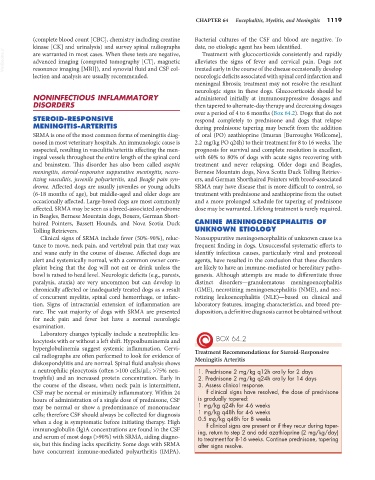Page 1147 - Small Animal Internal Medicine, 6th Edition
P. 1147
CHAPTER 64 Encephalitis, Myelitis, and Meningitis 1119
(complete blood count [CBC], chemistry including creatine Bacterial cultures of the CSF and blood are negative. To
kinase [CK] and urinalysis) and survey spinal radiographs date, no etiologic agent has been identified.
VetBooks.ir are warranted in most cases. When these tests are negative, alleviates the signs of fever and cervical pain. Dogs not
Treatment with glucocorticoids consistently and rapidly
advanced imaging (computed tomography [CT], magnetic
resonance imaging [MRI]), and synovial fluid and CSF col-
neurologic deficits associated with spinal cord infarction and
lection and analysis are usually recommended. treated early in the course of the disease occasionally develop
meningeal fibrosis; treatment may not resolve the resultant
neurologic signs in these dogs. Glucocorticoids should be
NONINFECTIOUS INFLAMMATORY administered initially at immunosuppressive dosages and
DISORDERS then tapered to alternate-day therapy and decreasing dosages
over a period of 4 to 6 months (Box 64.2). Dogs that do not
STEROID-RESPONSIVE respond completely to prednisone and dogs that relapse
MENINGITIS-ARTERITIS during prednisone tapering may benefit from the addition
SRMA is one of the most common forms of meningitis diag- of oral (PO) azathioprine (Imuran [Burroughs Wellcome],
nosed in most veterinary hospitals. An immunologic cause is 2.2 mg/kg PO q24h) to their treatment for 8 to 16 weeks. The
suspected, resulting in vasculitis/arteritis affecting the men- prognosis for survival and complete resolution is excellent,
ingeal vessels throughout the entire length of the spinal cord with 60% to 80% of dogs with acute signs recovering with
and brainstem. This disorder has also been called aseptic treatment and never relapsing. Older dogs and Beagles,
meningitis, steroid-responsive suppurative meningitis, necro- Bernese Mountain dogs, Nova Scotia Duck Tolling Retriev-
tizing vasculitis, juvenile polyarteritis, and Beagle pain syn- ers, and German Shorthaired Pointers with breed-associated
drome. Affected dogs are usually juveniles or young adults SRMA may have disease that is more difficult to control, so
(6-18 months of age), but middle-aged and older dogs are treatment with prednisone and azathioprine from the outset
occasionally affected. Large-breed dogs are most commonly and a more prolonged schedule for tapering of prednisone
affected. SRMA may be seen as a breed-associated syndrome dose may be warranted. Lifelong treatment is rarely required.
in Beagles, Bernese Mountain dogs, Boxers, German Short-
haired Pointers, Bassett Hounds, and Nova Scotia Duck CANINE MENINGOENCEPHALITIS OF
Tolling Retrievers. UNKNOWN ETIOLOGY
Clinical signs of SRMA include fever (50%-90%), reluc- Nonsuppurative meningoencephalitis of unknown cause is a
tance to move, neck pain, and vertebral pain that may wax frequent finding in dogs. Unsuccessful systematic efforts to
and wane early in the course of disease. Affected dogs are identify infectious causes, particularly viral and protozoal
alert and systemically normal, with a common owner com- agents, have resulted in the conclusion that these disorders
plaint being that the dog will not eat or drink unless the are likely to have an immune-mediated or hereditary patho-
bowl is raised to head level. Neurologic deficits (e.g., paresis, genesis. Although attempts are made to differentiate three
paralysis, ataxia) are very uncommon but can develop in distinct disorders—granulomatous meningoencephalitis
chronically affected or inadequately treated dogs as a result (GME), necrotizing meningoencephalitis (NME), and nec-
of concurrent myelitis, spinal cord hemorrhage, or infarc- rotizing leukoencephalitis (NLE)—based on clinical and
tion. Signs of intracranial extension of inflammation are laboratory features, imaging characteristics, and breed pre-
rare. The vast majority of dogs with SRMA are presented disposition, a definitive diagnosis cannot be obtained without
for neck pain and fever but have a normal neurologic
examination.
Laboratory changes typically include a neutrophilic leu-
kocytosis with or without a left shift. Hypoalbuminemia and BOX 64.2
hyperglobulinemia suggest systemic inflammation. Cervi- Treatment Recommendations for Steroid-Responsive
cal radiographs are often performed to look for evidence of Meningitis Arteritis
diskospondylitis and are normal. Spinal fluid analysis shows
a neutrophilic pleocytosis (often >100 cells/µL; >75% neu- 1. Prednisone 2 mg/kg q12h orally for 2 days
trophils) and an increased protein concentration. Early in 2. Prednisone 2 mg/kg q24h orally for 14 days
the course of the disease, when neck pain is intermittent, 3. Assess clinical response.
CSF may be normal or minimally inflammatory. Within 24 If clinical signs have resolved, the dose of prednisone
hours of administration of a single dose of prednisone, CSF is gradually tapered:
may be normal or show a predominance of mononuclear 1 mg/kg q24h for 4-6 weeks
cells; therefore CSF should always be collected for diagnosis 1 mg/kg q48h for 4-6 weeks
0.5 mg/kg q48h for 8 weeks
when a dog is symptomatic before initiating therapy. High If clinical signs are present or if they recur during taper-
immunoglobulin (Ig)A concentrations are found in the CSF ing, return to step 2 and add azathioprine (2 mg/kg/day)
and serum of most dogs (>90%) with SRMA, aiding diagno- to treatment for 8-16 weeks. Continue prednisone, tapering
sis, but this finding lacks specificity. Some dogs with SRMA after signs resolve.
have concurrent immune-mediated polyarthritis (IMPA).

